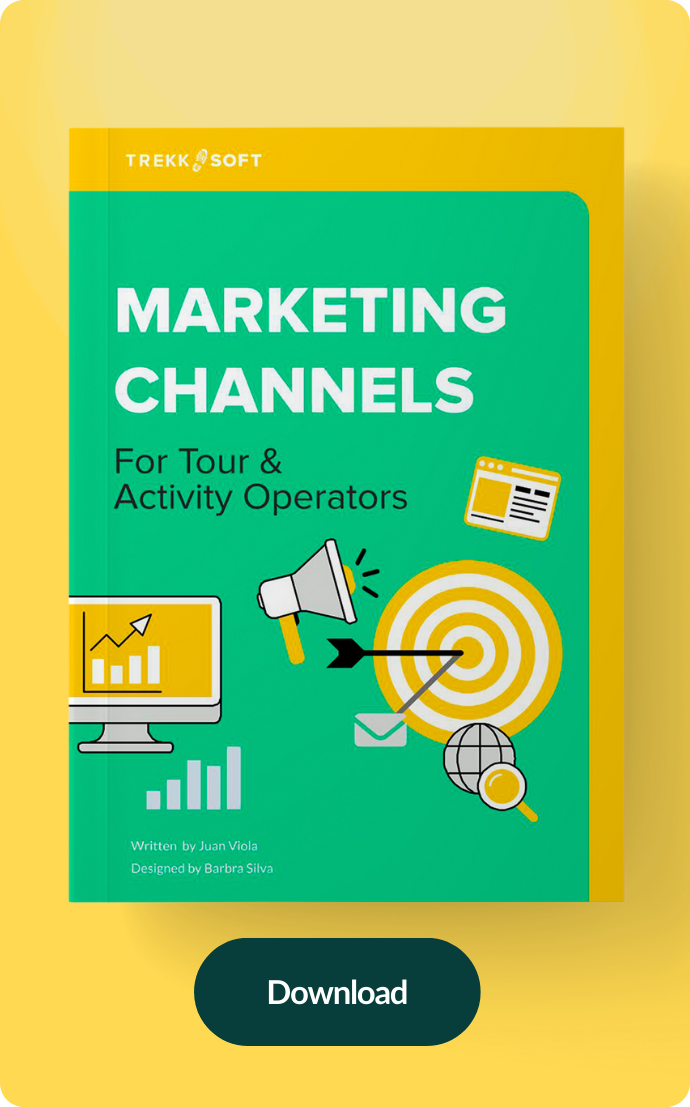Creating a tour package is like crafting a beautiful mosaic, where each piece – activities, transportation, unique experiences – comes together to form a seamless adventure. These packages not only make travel planning a breeze for your customers but also boost your sales by offering a complete and irresistible experience. In fact, a report shows that tours and cultural experiences are traveler’s top priorities when finding travel packages. This guide focuses on bundling exciting activities to create memorable tours that will keep your clients coming back for more.
Starting with your packages
The first step in crafting tour packages is understanding what your target audience desires. Conducting thorough market research, identifying trends and considering the unique selling points of your destination are crucial. These insights help design packages that cater to various types of travelers, such as adventure seekers or culture enthusiasts.
Conduct market research
Understanding your audience is key to creating tour packages that resonate. Start by analyzing demographic data to see who your typical customers are. Look at factors such as age, gender, nationality, and income level. This information can give you a clear picture of your target market.
Next, dive into their travel preferences. Are they solo travelers, families, or groups of friends? Do they prefer luxury experiences, budget-friendly options, or something in between? Knowing these details helps tailor your packages to meet their needs and expectations.
Gathering this information can be done through various methods:
- Surveys and questionnaires: Use online surveys to gather information directly from your potential customers. Ask about their travel preferences, budget, preferred activities, and any special requirements they might have.
- Social media insights: Platforms like Instagram, Facebook, and Twitter are treasure troves of information. Analyze the hashtags, comments, and posts related to your destination to understand what travelers are looking for.
- Industry reports: Leverage industry reports and market research studies that provide insights into current travel trends and consumer behaviors.
Identify trends
Staying updated with travel trends is crucial for designing packages that resonate with your audience. The travel industry is dynamic, with new trends emerging regularly. Here are a few ways to keep your finger on the pulse:
- Travel blogs and magazines: Follow popular travel blogs and online magazines like Conde Nast Traveler and Lonely Planet. They often highlight emerging travel trends and destinations.
- Travel forums: Engage with communities on travel forums such as TripAdvisor and Reddit. These platforms provide real-time insights into what travelers are discussing and interested in.
- Feedback from previous clients: Your past clients are a goldmine of information. Gather feedback from them to understand what they enjoyed and what could be improved. Use this feedback to tweak your future packages.
Highlight unique selling points
Every destination has unique aspects that can be turned into selling points for your tour packages. These could be natural attractions, cultural experiences, local cuisine, or unique activities. Identifying and highlighting these can set your packages apart from the competition.
- Scenic landscapes: If your destination boasts breathtaking views, incorporate activities that allow travelers to immerse themselves in these landscapes. Hiking, scenic drives, and photography tours are great options.
- Rich history: Highlight historical sites and offer guided tours that delve into the local history. Interactive experiences, like historical reenactments or visits to heritage sites, can be very appealing.
- Unique activities: Offer experiences that are unique to your location. This could be anything from traditional cooking classes, and artisan workshops, to wildlife safaris. The key is to provide something that travelers can’t find elsewhere.
Understand different traveler types
Different travelers have different needs and expectations. To create packages that cater to a wide range of travelers, it’s important to understand these differences and tailor your offerings accordingly.
- Adventure seekers: These travelers are looking for adrenaline-pumping activities like rock climbing, white-water rafting, or paragliding. Design packages that include a mix of high-energy activities and some downtime to relax.
- Culture enthusiasts: These travelers want to immerse themselves in the local culture. Offer packages that include museum tours, local festivals, traditional cooking classes, and visits to historical landmarks.
- Families: Family travelers look for activities that can be enjoyed by all age groups. Include family-friendly activities like zoo visits, amusement parks, and beach outings. Make sure there are options for both adults and children.
- Solo travelers: These travelers often look for a mix of adventure and relaxation. Offer packages that include group activities where they can meet new people, as well as some time alone to explore at their own pace.
Create comprehensive itineraries
Once you’ve gathered all this information, the next step is to create comprehensive itineraries that balance excitement and relaxation. Here’s how you can go about it:
- Balanced itinerary: Ensure your itinerary has a mix of activities. For instance, if your package includes a full-day adventure activity, follow it up with a relaxing activity the next day. This balance keeps travelers energized and engaged.
- Include free time: Don’t over-schedule your itineraries. Allow some free time for travelers to explore on their own, do some shopping, or simply relax. This flexibility can enhance their overall experience.
- Logistical coordination: Plan your itinerary to minimize travel time between activities. Efficient logistics ensure travelers spend more time enjoying the activities rather than commuting. Work closely with local transport providers to ensure smooth transitions.
Test and iterate
Did you know that online sales in the package travel market make up about 77% of revenue? This is why it’s so important to make sure your system works. Before rolling out your tour packages on a large scale, it’s wise to test them with a smaller group. This allows you to identify any potential issues and gather feedback to refine your offerings.
- Pilot groups: Offer your packages to a small group of travelers, perhaps at a discounted rate, in exchange for detailed feedback. This real-world testing can provide valuable insights.
- Continuous improvement: Use the feedback to make necessary adjustments. This could involve tweaking the itinerary, adding or removing activities, or adjusting the pricing. Continuous improvement based on customer feedback ensures your packages remain relevant and appealing.
Best practices for creating activity packages
Creating a balanced itinerary that offers value and excitement is key to making your tour packages stand out. Here are some best practices to follow:
Competitive yet profitable pricing
Make your package pricing attractive to potential customers while still being profitable for your business. Competitive pricing doesn’t always mean the lowest price; it means offering good value for the cost. Consider the cost of each activity, transportation, and any additional services included in the package.
Mix popular spots and hidden gems
A well-rounded tour package includes both well-known attractions and lesser-known spots. This combination provides a comprehensive experience and a sense of discovery. Highlighting hidden gems can make your packages more appealing to repeat travelers looking for new experiences.
Examples
Here are a few examples of successful tour packages and what makes them great:
- Adventure seeker package: This package includes activities like white-water rafting, zip-lining, and mountain biking. It’s designed for thrill-seekers looking for an adrenaline rush. The key to its success is the balance between high-energy activities and moments of relaxation, such as a scenic picnic or a visit to a local spa.
- Cultural immersion package: This package offers guided tours of historical sites, cooking classes with local chefs, and traditional dance performances. It appeals to travelers interested in experiencing the local culture deeply. The inclusion of interactive elements like cooking classes makes it engaging and memorable.
Customize experiences
Personalization is a key trend in the travel industry. Offering customizable options within your packages can significantly enhance their appeal. Allow customers to choose from a selection of activities or add special experiences to their package. This flexibility can cater to diverse interests and preferences, making each package feel unique.
Prioritize customer feedback
Customer feedback is invaluable for refining your tour packages. Encourage customers to share their experiences and suggestions. Use this feedback to make continuous improvements, keeping your offerings relevant and appealing.
Offer seasonal packages
Seasonal packages can attract customers looking to experience the best of your destination at different times of the year. Whether it’s a winter adventure or a summer festival, tailoring packages to seasonal highlights can boost interest and bookings.
Bundle value-added services
Adding value to your packages can set you apart from competitors. Consider including complimentary services like welcome gifts, professional photography, or local guidebooks. These small touches can enhance the perceived value and overall experience of your tour packages.
Collaborate with local partners
Partnering with local businesses can add depth and variety to your packages. Collaborate with local artisans, restaurants, and cultural institutions to offer exclusive experiences that customers wouldn’t find on their own. This not only enriches the package but also supports the local economy.
Build packages with TrekkSoft
.gif?width=1920&height=1080&name=packages%20(1).gif)
TrekkSoft is a powerful tool that simplifies the process of creating and managing tour packages. You can use TrekkSoft’s Back Office Management Tool to manage your packages. Here are some of the features that make it invaluable for tour operators:
- Quickly design and manage activity bundles with easy-to-set prices and bookings, streamlining operations and minimizing errors.
- Offer packages restricted to specific times, which can help you personalise experiences, optimise your resources, promote off-peak attendance and combine activities efficiently.
- Collect information you need from customers during booking to collect special requirements, feedback or to offer a more personalized experience.
- Create packages with your partners' activities on our platform. Partnering with other activity operators can enhance your offerings and create a more valuable experience for your customers.
Ready to take your tour packages to the next level? Schedule a demo with TrekkSoft today and discover how our tools can help you craft irresistible packages that captivate your audience and boost your sales.




